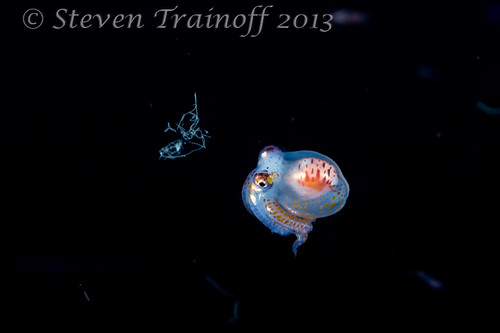Most excellent.
Do you mind sharing some of your "secrets," such as how you achieved such sharp focus on these tiny floating critters?
Sure. First of all, you need to realize that you are photographing subjects that in other context would be called
backscatter. So throw out the window all of the usual lessons of strobe placement. I used a 100mm macro lens behind a flat port and pushed my strobe arms in front of the lens, angled sharply inwards. I have a SOLA 2000 video light on top of my housing that I used as a focus light and I put it on narrow beam pointed at the intersection of the two strobes. This formed a "sweet spot" for shooting that was about 2ft in front of the port. I put my hand in the sweet spot and pre-focused on it. Then when I found a subject I would slowly swim towards it until I got it in the sweet spot and let the lens fine-tune the focus. Since the lens was already close to the right focus, it snapped into focus pretty quickly and avoided "hunting." The subjects are almost transparent so it is hard to get enough light on them. I set the strobes on full and used between f/16 to f/25 with a high ISO to get a good depth of field.
I did this dive twice. Although the method described above worked pretty well for the first dive, I wanted more magnification to better fill the frame on some of the tiny macro critters, so I tried a new configuration (which I have never dived with). I put both extension rings on my camera and put my 100mm macro lens on with a 2x tele-converter (inside the housing), essentially creating a 200mm lens. I knew that this was an experiment and sure enough, it was much less successful. The sweet spot moved out to about 3ft and it had a lot harder time focusing. Instead I gave up on autofocus, locked the focus, and moved the camera in and out until the subject was sharp, then fired. There were two problems. First, since the sweet spot was so far out, I got a lot more backscatter and I had a hard time getting enough light on my subjects. And perversely, the subjects on the second dive were mostly salps and jellys that were so big that they overfilled the frame unless I got even further back (4ft) which compounded the problems.
If I do this dive again, I would probably go the other direction and use a 60mm macro lens and try to get closer. The problem is that the nice bright video light that helps the camera focus, attracts plankton, and scares off many of the of the light sensitive creatures. You could see some of these gelatinous creatures use sticky nets to capture plankton. When you shine your light on them, they pull in the nets and wriggle away.
It was definitely tricky photography, but I like challenges.













